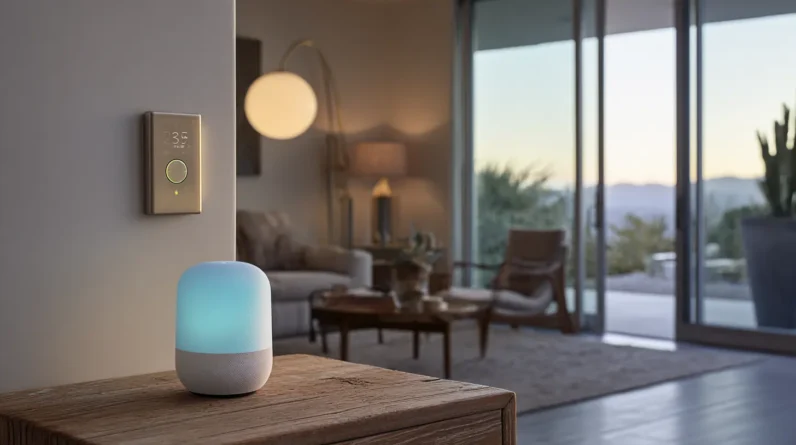
When we look at smart home devices, we find features like voice control integration, which boosts convenience by letting us adjust settings with a simple command. Automation capabilities streamline our routines, while energy efficiency features help us save money and reduce our carbon footprint. Remote access guarantees we’re always in control, even when we’re not home. But this is just the start; understanding how these features work together is where we see the real magic happen.
Voice Control Integration
Voice control integration is a cornerstone of modern smart home devices, allowing us to interact with technology in an intuitive and hands-free manner. By leveraging Voice Assistants like Amazon Alexa, Google Assistant, and Apple’s Siri, we can control various aspects of our home environment simply by speaking. The key to effective voice control is advanced Speech Recognition technology, which enables these assistants to understand and respond to our commands accurately.
To maximize the benefits, we should guarantee our devices are compatible with our preferred Voice Assistant. This integration streamlines daily tasks, from adjusting the thermostat to turning off lights, enhancing both convenience and efficiency. Furthermore, voice control can be particularly useful for individuals with mobility challenges, providing an accessible way to manage home systems. However, it’s vital to take into account privacy implications, as voice-activated devices are always listening. Balancing convenience with security is essential for a well-rounded smart home experience.
Automation Capabilities
Beyond the convenience of voice control, we find another key aspect of smart home devices: automation capabilities. These features allow our devices to work together seamlessly, creating a harmonious ecosystem that adapts to our daily routines. Let’s break down the essentials:
- Scene Planning: We can set predefined scenes like “Movie Night” or “Good Morning” to adjust lighting, temperature, and music with a single command.
- Scheduling: Automating tasks based on time, such as turning off lights at bedtime or brewing coffee in the morning.
- Trigger Actions: Using sensors or other inputs to initiate actions, like turning on lights when motion is detected.
- Automation Protocols: Ensuring compatibility and smooth interaction between devices from different manufacturers, using standards like Zigbee or Z-Wave.
Energy Efficiency
Smart home devices aren’t just about convenience; they also play a significant role in helping us manage our energy consumption more effectively. By integrating power monitoring and energy tracking features, these devices provide us with valuable insights into our daily usage. Imagine being able to see exactly how much energy each appliance consumes and identifying areas where we can cut back. With real-time data, we can make informed decisions, like turning off devices that are on standby or scheduling high-consumption activities during off-peak hours. Additionally, some smart devices can even learn our routines and automatically adjust settings to optimize energy use, ensuring that we’re not wasting power when it’s not needed. This level of control not only helps us reduce our carbon footprint but also saves us money on utility bills. Understanding and leveraging these energy efficiency features can truly elevate our smart home experience, making it both sustainable and cost-effective.
Remote Access
While energy efficiency is a key benefit of smart home devices, another advantage that substantially enhances our experience is remote access. This feature allows us to control our devices from anywhere at any time, providing unparalleled convenience and flexibility. With remote access, we can guarantee our home is secure, adjust the thermostat, or turn off lights even when we’re not physically present.
- Mobile Accessibility: We can manage our smart home devices through user-friendly apps on our smartphones or tablets. This means we’re always in control, whether we’re at work, on vacation, or simply in another room.
- Wireless Connectivity: Remote access relies on wireless connectivity, typically via Wi-Fi or cellular networks. This guarantees that our commands are sent and received instantaneously.
- Real-Time Monitoring: We can check the status of our devices in real-time. For instance, we can see if our front door is locked or if the lights are on.
- Automation: With remote access, we can schedule tasks or set up automated routines. Our smart home can greet us with a well-lit room and comfortable temperature as soon as we step inside.
Remote access isn’t just about convenience; it’s about creating a home that responds to our needs intuitively.
Compatibility and Connectivity
One of the vital aspects that determine the effectiveness of a smart home ecosystem is compatibility and connectivity. We need to guarantee our devices can communicate seamlessly with each other, regardless of manufacturer. Device pairing should be straightforward, with open protocols like Zigbee or Z-Wave facilitating this process. Additionally, understanding the network requirements of each device is essential. Some may operate on 2.4GHz Wi-Fi, while others might require a hub that supports specific frequencies. A mesh network can enhance connectivity, guaranteeing that commands and data flow smoothly throughout the home. Always check the device specifications to confirm they align with your existing network infrastructure.
Security Features
As we integrate more devices into our smart home ecosystem, it becomes imperative to weigh the security features that protect our data and privacy. We must guarantee our smart home devices are equipped with robust security measures to prevent unauthorized access and data breaches. Key security features to ponder:
- Encryption: Data transmitted between devices should be encrypted to prevent interception by hackers.
- Authentication: Strong authentication methods, such as two-factor authentication, guarantee only authorized users can access and control devices.
- Motion Sensors and Alarm Systems: These features not only enhance physical security but also integrate with smart home systems to alert us of any unusual activity.
- Regular Updates: Devices should receive regular software updates to patch vulnerabilities and improve security.
User-Friendly Interface
After ensuring our smart home devices are secure, we naturally want them to be easy to use. This is where a user-friendly interface comes into play. An intuitive design is vital; it allows us to navigate the device’s functions effortlessly. We shouldn’t need a manual to perform basic tasks. The interface should be straightforward, with clear icons and logical menu structures. Customization options are also important. They enable us to tailor the device to our specific needs and preferences, enhancing our overall experience. Whether it’s adjusting the layout, creating shortcuts, or setting up automated routines, these options give us control. A well-designed interface anticipates our needs, reducing the learning curve and making interactions seamless. It’s not just about aesthetics; it’s about functionality that integrates smoothly into our daily lives.
Conclusion
When we integrate smart home devices, we’re not just adding convenience, but also efficiency and security. With over 60% of homeowners considering energy efficiency a key factor in smart home adoption, it’s clear these devices are more than just gadgets. They’re tools that help us manage our homes better, from anywhere, at any time. By choosing devices with strong voice control, automation, and remote access features, we’re investing in a home that works with and for us.







